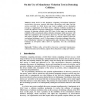Free Online Productivity Tools
i2Speak
i2Symbol
i2OCR
iTex2Img
iWeb2Print
iWeb2Shot
i2Type
iPdf2Split
iPdf2Merge
i2Bopomofo
i2Arabic
i2Style
i2Image
i2PDF
iLatex2Rtf
Sci2ools
ICOIN
2007
Springer
2007
Springer
On the Use of Manchester Violation Test in Detecting Collision
Smart devices in the ubiquitous computing environment implement service/device discovery protocol that helps discovering each other and the services provided. As client device may receive multiple service description messages, it implements at its MAC layer a collision resolution mechanism to resolve the collision of messages. Effectiveness of collision resolution relies on the accuracy of detecting collision at the PHY layer. In this paper, we question the reliability of the conventional collision detection technique, which inaccuracy will affect the completeness of service/device discovery. We show that capture effect and packet reception failure can cause failure in collision detection when the conventional technique is used. We then suggest a detection technique that makes use of Manchester violation test. Implementation and evaluation of the proposed technique on low-power radios show its superiority over the conventional approach.
Related Content
| Added | 08 Jun 2010 |
| Updated | 08 Jun 2010 |
| Type | Conference |
| Year | 2007 |
| Where | ICOIN |
| Authors | Yee-Loo Foo, Hiroyuki Morikawa |
Comments (0)

